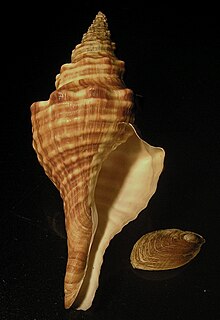| Africofusus ocelliferus | |
|---|---|

| |
| Africofusus ocelliferus and operculum | |
| Scientific classification | |
| Domain: | Eukaryota |
| Kingdom: | Animalia |
| Phylum: | Mollusca |
| Class: | Gastropoda |
| Subclass: | Caenogastropoda |
| Order: | Neogastropoda |
| Family: | Fasciolariidae |
| Genus: | Africofusus |
| Species: | A. ocelliferus |
| Binomial name | |
| Africofusus ocelliferus (Lamarck, 1816) | |
| Synonyms | |
| |
Africofusus ocelliferus, common name the long-siphoned whelk, is a species of sea snail, a marine gastropod mollusk in the family Fasciolariidae, the spindle snails, the tulip snails and their allies.
Spelling
The specific name was originally spelled "ocelliferus"; although this is not a correct latinization it is not liable to a justified emendation (cf. ICZN art. 32.5.1. "Incorrect transliteration or latinization ... are not to be considered inadvertent errors"). The spelling ocellifer is therefore an unjustified emendation, which may be traced to Kaicher, 1976 (card n 1857)
Description
The length of the shell attains 160 mm.
The shell varies from narrowly to broadly spindle-shaped, with the spire comprising half to three-quarters of the total aperture length. The siphonal canal is long and slender, sometimes accounting for up to one-third of the total shell length, and is often slightly curved. The sculpture consists of coarse, flattened spiral ridges, though the prominence of these ridges varies widely between specimens. Some individuals display a distinct shoulder adorned with rounded nodules. A deep false umbilicus is often present beside the siphonal base in mature specimens. The inner lip lacks columellar pleats, and the interior of the outer lip is smooth.
The shell is whitish, with spiral ridges often spotted or mottled with brown. When present, the shoulder typically features darker brown spots, especially on the nodules. The periostracum is a velvety, horn-brown layer that often flakes off. The animal is orange-red.
Distribution
This marine species is endemic to South Africa and occurs off Namaqualand, West coast to KwaZulu-Natal South coast; infratidal to 150 m, perhaps to 300 m.
References
- ^ MolluscaBase eds. (2020). MolluscaBase. Africofusus ocelliferus (Lamarck, 1816). Accessed through: World Register of Marine Species at: http://marinespecies.org/aphia.php?p=taxdetails&id=1441254 on 2020-12-04
- ^ Herbert, D.G., Jones, G.J. & Atkinson, L.J. (2018). Phylum Mollusca. In: Atkinson, L.J. and Sink, K.J. (eds) Field Guide to the Offshore Marine Invertebrates of South Africa. Pretoria: Malachite Marketing and Media. p. 289. doi:10.15493/SAEON.PUB.10000001. ISBN 978-1-86868-098-6. Retrieved 17 October 2024.
{{cite book}}: CS1 maint: multiple names: authors list (link) This article incorporates text from this source, which is available under the CC BY-SA 4.0 license.
This article incorporates text from this source, which is available under the CC BY-SA 4.0 license. This article incorporates text from this source, which is in the public domain.
This article incorporates text from this source, which is in the public domain.
- Lamarck J.B. (1816). Liste des objets représentés dans les planches de cette livraison. In: Tableau encyclopédique et méthodique des trois règnes de la Nature. Mollusques et Polypes divers. Agasse, Paris. 16 pp.
- Steyn DG and Lussi M. (2005). Offshore shells of southern Africa: A pictorial guide to more than 750 gastropods. published by the authors. p. 148.
- Marais JP and Kilburn RN. (2010). Fasciolariidae. In: Marais AP and Seccombe AD (eds) Identification Guide to the Seashells of South Africa. Vol. 1. Groenkloof. Centre for Molluscan Studies. p. 136.

External links
- Branch, G.M. et al. (2002). Two Oceans. 5th impression. David Philip, Cate Town & Johannesburg.
- Lamarck [J.B.P.A. de M. de]. (1816). Tableau encyclopédique et méthodique des trois règnes de la nature, Mollusques et polypes divers. Part 23 [Livraison 84, 14 December 1816], Tome 3, pp. 1–16, pls. 391-431, 431 bis, 431 bis*, 432-488, Paris: Vve Agasse
- Smith E.A. (1899). Descriptions of new species of South African marine shells. Journal of Conchology. 9: 247-252, pl. 5
| Taxon identifiers | |
|---|---|
| Africofusus ocelliferus | |
| Fusinus ocelliferus | |
This Fasciolariidae-related article is a stub. You can help Misplaced Pages by expanding it. |